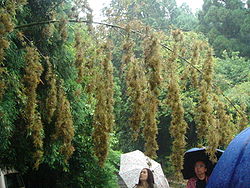- Mautam
-
Mautam (Mizo, ’bamboo death’; also spelt mautaam[citation needed]) is a cyclic ecological phenomenon that occurs every 48 years in the northeastern Indian states of Mizoram and Manipur, which are thirty percent covered by wild bamboo forests, as well as Chin State in Burma, particularly Hakha, Thantlang, Falam, Paletwa and Matupi Townships, creating a widespread famine in those areas.[1] At this time, Melocanna baccifera, a species of bamboo, flowers at one time across a wide area.
This event is followed invariably by a plague of Black Rats in what is called a rat flood.[2][3] This occurs as the rats multiply in response to the temporary windfall of seeds and leave the forests to forage on stored grain when the bamboo seeds are exhausted, which in turn causes devastating famine.[4] In the past, famines caused by this phenomenon have played a significant part in shaping the region's political history. The most recent spate of flowering, on the bamboo species' genetically-linked timetable, began in May 2006, and the state government and the Indian Army attempted to prevent a famine.
Contents
Mechanism
After flowering, the bamboo dies and regenerates from the seeds. The rodents feast on these seeds which are available in plenty. In consequence, there is a sudden boom in the rat population. The action of the rats is thought to be an ecological control mechanism. The seeds of any culm of bamboo that might flower off-cycle are all eaten up by rodents, thus reinforcing the rhythm of this extreme version of a mast year. Some experts believe that the flower has a positive effect on the fertility of the rats, as well as on increasing the viable size of a rat litter. All available explanations point to the fact that the increase in their numbers during the peak year is a natural after-effect of the flowering of the bamboos.
However, once they exhaust this temporarily abundant food supply, the rats turn their attention to cultivated crops. Records from the British Raj indicate that Mizoram suffered famine in 1862 and again in 1911, after the region witnessed similar bamboo flowerings. In each case, the records suggest that the flowering of the bamboo leads to a dramatic increase in the local rat population. The increase led to raids on granaries and the destruction of paddy fields, and subsequently to a year-long famine.
The 1958–1959 Mautam resulted in the recorded deaths of at least a hundred people, besides heavy loss to human property and crops. Some elderly villagers in the undeveloped more traditional region, recalling this event, have claimed that their warnings based on folk traditions were dismissed as superstition by the Government of Assam, which then ruled what is now the state of Mizoram. It has been estimated that around two million rats were killed and collected by the locals, after a bounty of 40 paisa (approximately 1 US cent according to present-day rates) was placed on each. However, even after the increase in the rat population was noted, preparations by the government to avoid a famine were limited.
This negligence led to the foundation of the Mizo National Famine Front, set up to provide relief to the far-flung areas. This body later became the Mizo National Front (MNF), which staged a major uprising in 1966. Under its leader Laldenga (who later became the Chief Minister of Mizoram), MNF fought a bitter separatist struggle for twenty years against the Indian Army until an accord that guaranteed Mizoram's autonomy as a separate state was signed in 1986.
Chief Minister Zoramthanga, a former guerrilla leader, made preparations for the predicted 2006 Mautam for two years. In June 2006, the Indian Army was pressed into service as an emergency measure to assist the state administration in reaching remote areas. The state administration arranged for alternate food crops to be grown locally; and also arranged for the army to provide instructions on pest control. Villagers were encouraged to grow turmeric and ginger, partially as an insurance against variations in purchasing power, and also because the aromatic spices ward off rodent raids.
Regular rodent outbreaks associated with bamboo flowering (and subsequent fruiting and seeding) also occur in the nearby Indian states of Arunachal Pradesh, Manipur, and Nagaland,[5] as well as in Laos, Japan, Madagascar and South America.[6] Thingtam, a similar famine, occurs with the flowering of another bamboo, Bambusa tulda.[7]
See also
References
- ^ http://www.mizzima.com/news/inside-burma/4-inside-burma/831-swarms-of-rats-destroy-crops-in-townships-in-chin-state
- ^ Rat Attack, Plant vs. Predator
- ^ Normile D (February 2010). "Holding back a torrent of rats". Science 327 (5967): 806–7. doi:10.1126/science.327.5967.806. PMID 20150483.
- ^ Peter Foster, Bamboo threatens to bring Indian famine, 14 October 2004
- ^ Rodent problems in India and strategies for their management (PDF format)
- ^ Rodent outbreaks in the uplands of Laos: analysis of historical patterns and the identity of nuu khii (PDF format)
- ^ H. Y. Mohan Ram. A passion for plant life. Journal of Biosciences 27 (7) 2002. Pages 659-660.
External links
- In India's Mizoram, Bamboo Mean Dreams, Nightmares In 1959 ... widespread food shortages. In 2007, the government hopes to be better prepared. Reuters, 27-Apr-05.
- Indian army's new enemy is rats "troops in the six north-eastern states of the country are used to dealing with insurgencies" but are now dealing with "an infestation of rats", BBC, 3 June 2006.
- Bamboo the life blood of the people: Alarm to Ecosystem
- Mizoram Bamboo
- Mautaam in Manipur
- Rat Attack, Plant vs. Predator, "noted ecologist Daniel Janzen" "describes how Melocanna bamboo's strategy came about", NOVA PBS, interview 30th Sep 2008.
Categories:- Bamboo taxa
- Famines
- Periodic phenomena
Wikimedia Foundation. 2010.

